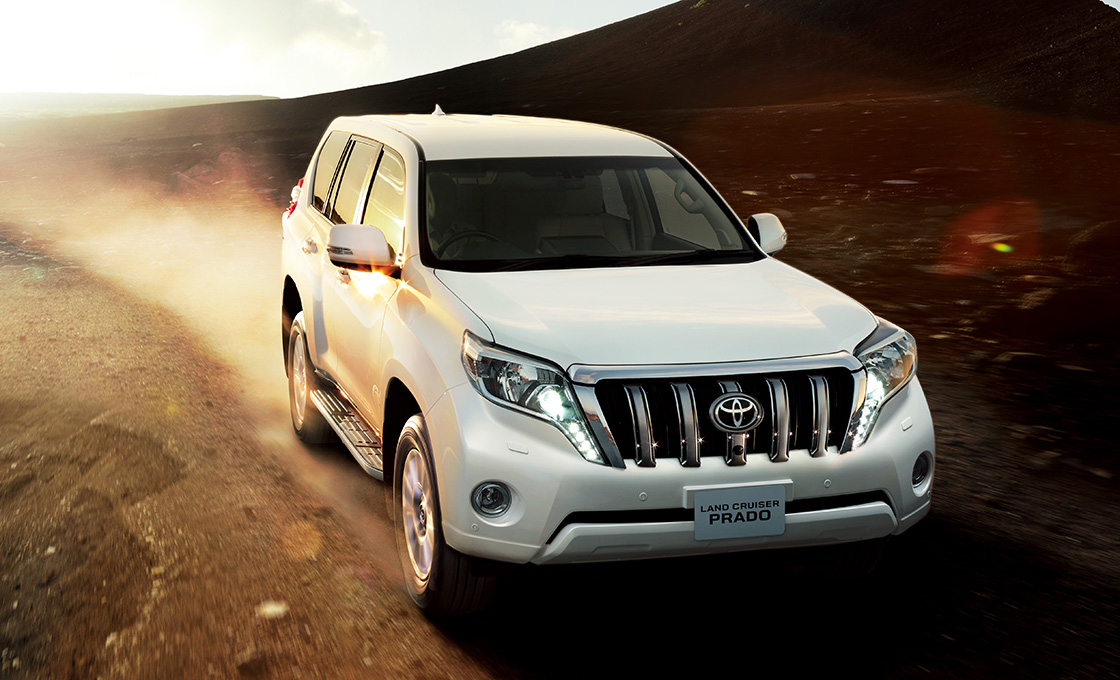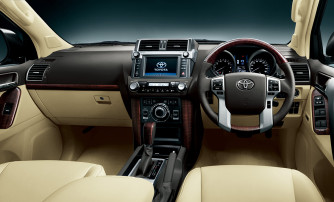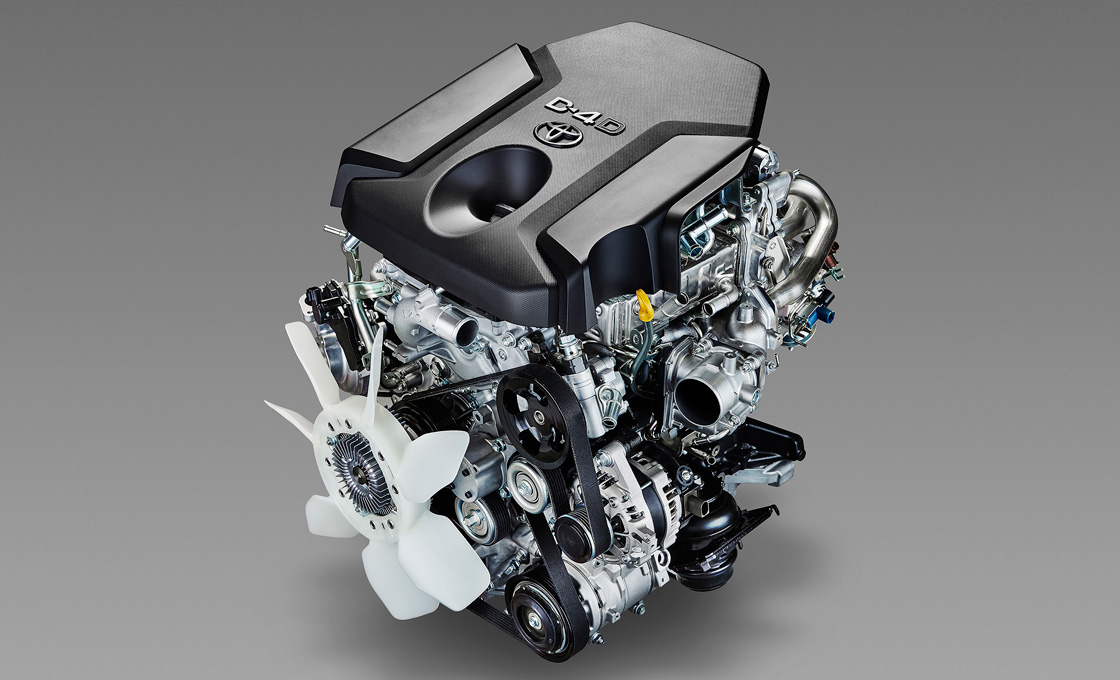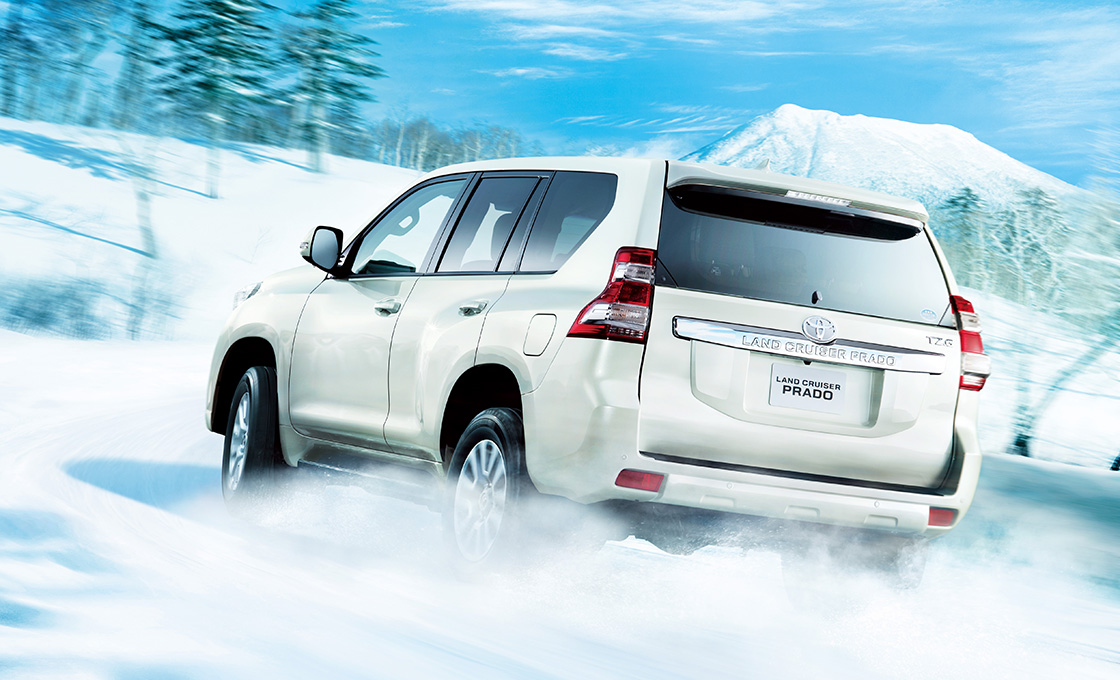What is the Land Cruiser 150 Prado?
Electronic control technology for driving is here!
The Land Cruiser 150 Prado is a light-duty Land Cruiser that debuted in September 2009 as the successor to the Land Cruiser 120 Prado. The light-duty Land Cruiser originated from the 70 Wagon released in 1985 which was derived from the heavy-duty Land Cruiser 70 Van.
The history of “The Prado” began with the next-generation Land Cruiser 70 Prado, followed by the 90 Prado, 120 Prado, and this 150 Prado. Originally, the light-duty Land Cruiser was a practical and comfortable multi-purpose SUV for a wide range of users like the heavy-duty 70 Van workhorse that takes on the world’s roughest roads and is the series flagship (the current model is the Land Cruiser 200).
However, the Land Cruiser 150 Prado has evolved to a degree of luxury that is as close to the Land Cruiser 200 as possible and has acquired the ability to compete with the 70 Van in terms of off-road driving performance. Such specifications and performance were made possible by significantly increasing the rigidity of the frame and body and by adopting high-performance electronic control devices that support driving performance for comfort and safety. Of course, this also applies to the evolution of manufacturing technology that has improved the quality of interiors like the instrument panels and seats. It is so much like the Land Cruiser 200 that the only differences are the engine and the body size.
Land Cruiser 150 Prado Exterior and interior comparison with successive models
| Model | Land Cruiser 90 Prado | Land Cruiser 120 Prado | Land Cruiser 150 Prado |
|---|---|---|---|
| Sale Period | May 1996 to September 2002 | October 2002 to August 2009 | September 2009~ |
| Full Length | 184 inches | 186 inches | 187 inches |
| Width | 72 inches | 74 inches | 74 inches |
| Height | 75 inches | 73 inches | 72 inches |
| Minimum Turning Radius | 224 inches | 224 inches | 228 inches |
| Vehicle Weight | 3,836 – 4,497 pounds | 4,145 – 4,542 pounds | 4,497 – 5,071 pounds |
| Boarding Capacity | 5~8people | 5~8people | 5~7people |
| Engine Type | Gasoline: 2.7L (straight 4: 3RZ-FE) / 3.4L (V6: 5VZ-FE) Diesel: 3.0L (straight 4 turbo: 1KZ-TE) → 3.0L (straight 4 turbo: 1KD-FTV) | Gasoline: 2.7L (Straight 4: 3RZ-FE) → 2.7L (Straight 4: 2TR-FE) / 3.4L (V6: 5VZ-FE) → 4.0L (1GR-FE) Diesel: 3.0L (straight 4 turbo: 1KD-FTV) | Gasoline: 2.7L (straight 4: 2TR-FE) / 4.0L (V6: 1GR-FE) Diesel: 2.8L (straight 4 turbo: 1GD-FTV) |
| 4WD System | Full-Time | Part-Time | Full-Time |
| New Car Price | $19,500 – $25,800 | $22,300-$32,000 | $24,500-$37,600 |
*90 Prado, 120 Prado, and 150 Prado each have 4-door specs.
*Body size is a typical final model (excluding optional equipment, etc.)
*Vehicle weight does not include optional equipment
*The price when new is the manufacturer’s suggested retail price (tax included) of the final model.

The body size remains almost the same and its utility is greatly improved.
The Land Cruiser 150 Prado has a 5-door body style, unlike the previous 120 Prado, which had a 3-door/5-door configuration. The initial model has four trim levels: TX, TX/L package, TZ, and TZ-G. There are TX and TX/L packages for the 2.7L gasoline engine vehicles, and TZ and TZ-G are offered for the 4.0L gasoline engine vehicles in addition to the TX.
The body design has increased in weight, emphasizing strength compared to its predecessor. It can be said that it has a more established style by not having overfenders in all models. It is almost the same as the 120 Prado 5-door car in terms of body size.
The total length is 45mm/1.7 inches longer, but it seems the extra space was spent on the collision safety of the cabin and the redesign of the instrument panel. The interior length is the same as the 120 Prado. The major evolution point from the 120 Prado in the interior and exterior of the body is above all the utility of the space. The second-row seats are a 4:2:4 split folding type with a 135mm/5-inch sliding mechanism that expands the legroom. At the same time, a step up (left side) has been added to improve the ease of getting in and out of the 3rd-row seats. In addition, the third-row seat can be retracted and restored with a flip of a switch, and the floor surface has been lowered by 50mm/2 inches compared to the previous generation 120 Prado. The Land Cruiser 150 Prado has further enhanced inside capacity, and the ability to carry more people and more cargo, so as a passenger car, it has been greatly improved.

Numerous advanced functions improve safe, comfortable driving and performance on rough roads
The frame, which is the skeleton of the car, and the engine and suspension mounted on it have not changed much from the Land Cruiser 120 Prado, but that is a matter of form. The ladder-shaped frame has significantly increased rigidity, the engine has been reviewed for economic efficiency, output characteristics, and clean emissions performance and the powertrain and suspension have more electronic control technology.
Among these new technologies, it is the electronic control technology for the powertrain and suspension that has greatly improved driving performance. First of all, KDSS (Kinetic Dynamic Suspension System) optimally controls the stabilizer effect of the front and rear suspension according to the driving conditions. It has Crawl Control that automatically controls the engine and brakes while off-road and maintains extremely low speed while ensuring a high level of driving performance and stability, and a Multi-Terrain Select mode, which improves drivability by switching the action of traction control on the sand, rubble, moguls, rocky roads, etc. These are high-end features that were also used in the Land Cruiser 200, but the Land Cruiser 150 Prado is more effective due to its slightly smaller and lighter body. The stability and off-road driving performance are almost the same as the Land Cruiser 200, or even higher depending on the driving scene.

Land Cruiser 150 Prado Changes in specifications and equipment
September 2009
Land Cruiser 150 Prado appeared as a successor to the Land Cruiser 120 Prado. It will be a 5-door exclusive vehicle, and all cars will have a 3-number body classification with no overfenders. Due to the tightening of diesel exhaust gas regulations, the diesel engine was omitted, and two types of gasoline engines, a 4.0-liter V6, and a 2.7-liter in-line 4-cylinder, were installed.
September 2013
First minor change. The front grill was enlarged, and the design of the front bumper, rear combination lamps, and rear trim was changed. The multi-information display has been changed to a large color TFT liquid crystal to display a variety of information such as off-road driving support. At the same time, the Multi-Terrain Select has increased the driving settings from 4 to 5 modes. In addition, LED lamps have been adopted for the headlamps (low beam) in some upper trim levels.
June 2015
Some improvements: A 2.8-liter in-line 4-cylinder clean diesel engine replaces the 4.0-liter V6 gasoline engine. With the TX, TX/L package, you can choose between this 2.8-liter in-line 4 clean diesel engine and the 2.7-liter in-line 4 gasoline engine, and the highest trim level TZ-G is exclusively equipped with a 2.8-liter in-line 4 clean diesel engine.

Land Cruiser 150 Prado engine type
The Land Cruiser 150 Prado was initially equipped with only two types of gasoline engines: the 4.0-liter V6 1GR-FE and the 2.7-liter straight-4 2TR-FE. Then, at the time of partial upgrading in June 2015, a newly developed 2.8-liter straight-4 clean diesel engine was introduced, and the 4.0-liter V6 gasoline engine was omitted instead. It was the first time in about eight years since July 2007 that the Land Cruiser Prado was back with a diesel engine during the 120 Prado era.
Diesel engines had disappeared during that time because Japan’s diesel exhaust gas regulations were among the strictest in the world. In recent years, Europe, which is a large market for the Land Cruiser Prado, has raised the regulation value to the same level as Japan (Euro 6). It was also installed in the Japanese version 150 Prado.
This engine change is what diesel engine fans have been waiting for, and it will also bring more fans to the 150 Prado. In addition to its excellent fuel efficiency, it also has a strong, torquey feel, and its acceleration surpasses that of a gasoline engine of the same displacement. Moreover, the automobile tax is two ranks lower than the 4.0-liter V6 gasoline engine. There was some pushback against the vehicle price due to the state-of-the-art clean diesel engine equipped with a precise fuel injection system, but in the long run, the economic advantage is clear.
Land Cruiser 150 Prado test drive impressions & report

Gasoline and Clean Diesel, Each Has Its Merits
Most of the 150 Prado mass-market models TX and TX/L packages are selected with 2.7-liter in-line 4 gasoline engines. The greatest advantage of this engine is its good balance in terms of economy such as fuel consumption and taxes and it is perfectly matched to the 150 Prado. Compared to the 4.0-liter V6 petrol and the 2.8-liter in-line 4 clean diesel that replaced it, there is a clear difference in performance. However, it is just something you feel as you drive and compare the driving performance, which does not mean one is an inferior engine to the other.
Thanks to the AT’s superb shift timing, the smooth acceleration, and deceleration of this 2-ton body deliver a comfortable feeling of unity with the machine as you cruise the highway.
Comparing the new car price, it is $2,200 to $2,930 more reasonable than other engine-equipped models, so if economic efficiency is a priority, it is better to choose this one.
On the other hand, the 4.0-liter V6 gasoline engine-equipped car stands out for its somewhat basic energy in all aspects of driving. It feels touchy with its sensitive accelerator pedal, but if you use moderate acceleration, you can drive comfortably with a lot of power. Torque at low speeds is also perfect, and anyone driving off-road will be able to enjoy a powerful performance.
The newly developed 2.8-liter straight-4 clean diesel makes the 4.0-liter V6’s rough-hewn character feel grown-up and reliable. Even with the turbo, a thick torque rises from the low-speed range, and it pulls lightly to high-speed driving without feeling out of breath. Even when overtaking and accelerating, it reacts agilely and rides comfortably. It is completely different from the diesel engine of a decade ago, so if for the first time in more than 10 years, you are a fan of a Land Cruiser diesel car, you may be surprised at how powerful it is.
True multi-purpose 4WD with full use of electronic control
Various electronic controlled equipment greatly affects the driving performance of the Land Cruiser 150 Prado.
All of the controls work to provide an extremely stable and comfortable ride.
For example, KDSS suppresses rolls that occur in corners and maintains a stable vehicle posture. The Land Cruiser 150 Prado is tall with a high center of gravity, so it tends to have sway as it is. Its roll makes the occupants uneasy and makes driving unstable, but thanks to the KDSS function, the driver can hold the steering wheel in a natural posture while feeling the lateral G force. On mountain roads, cornering is smooth because you don’t have to slow down too much before a curve. Since unnecessary acceleration and deceleration are not required during cornering, the vehicle attitude does not become unstable and fuel consumption is consistent, which is a win-win situation.
In addition, the Multi-Terrain Select supports off-road driving. It is a device that automatically applies the brakes to the rotation of tires that slip or spin depending on the road surface conditions and transmits driving force to other tires that are in contact with the ground to maintain driving stability.
It is an evolved version of the 4-wheel TRC (traction control) used in the previous Land Cruiser 120 Prado, and you can set the dial for 4 to 5 road surface modes depending on the model year. The off-road terrain includes scenarios where the tires are hidden on uneven terrain and rocks that cause the body to tilt extremely, but in general, it is not suitable for use on snowy roads or dirt roads.
Tire slippage and tire spinning will cause a loss of traction and cause unstable speed changes in small increments. The fear is that the traction balance of the four wheels will be lost and the vehicle’s stability will be compromised. This is especially dangerous when turning on curves or when climbing or descending slopes. The Multi-Terrain Select constantly detects the movement of the suspension and the number of revolutions of each of the four tires and reacts immediately to maintain the stability of the vehicle if it anticipates a problem.
Land Cruiser 150 Prado points to consider when choosing a used car

There are still a few in the used car market, but the target is the middle trim level
Since it was released in September 2009, the number of vehicle inspections for the Land Cruiser 150 Prado on the used car market is at most two. There are quite a few units on the market. Most of the models are the 2.7-liter in-line 4-gasoline TX and TX/L packages. Since it is an engine that is also installed in the current model, the value has not dropped so much, so the price has not dropped significantly.
You can also find models that are either factory equipped or very close to it. So the point to consider is the difference in equipment. Most of the higher models ZX and ZX-G are equipped with comfortable equipment as standard from the factory, but there are various TX, TX / L packages. Multi-terrain Select is useless if you don’t have the opportunity to go off-road. I would check the various features carefully before deciding to purchase one. However, if you want a clean diesel engine, you have to be prepared to spend over $29,000. It’s been less than a year since the additional release, so they are in good condition.
Long years of development
Seven years after its release, it may be time to start wondering about the debut of the next-generation Prado. However, the Land Cruiser 150 Prado has reached the point where it has matured as a Prado, so that makes it a good decision to buy a used car rather than wait for the next one.
The reason why we can say that the Prado is fully developed is that most of the functional changes from the previous Land Cruiser 120 Prado are in the electronically controlled equipment. Next, the diesel engine, which is the ultimate prize for Land Cruiser fans, is now a clean diesel. The specifications and equipment of the high-end Land Cruiser 200, which influence each other, have not changed significantly for a while, and the features of the 150 Prado have almost caught up with the Land Cruiser 200.
I don’t know how the Land Cruiser will evolve in the future, but there is no other vehicle on the market that is as comfortable, always reliable, customizable, and dependable on any road. Get a cross-country Land Cruiser now before Land Cruisers become more expensive and are powered by hybrids and fuel cells.
How robust is the Land Cruiser 150 Prado?
To see the Land Cruiser 150 Prado’s capabilities on rugged roads, check out this video in which we compared the Land Cruiser 150 Prado and Renoca 106, our original retrofitted Land Cruiser 100 series, to see how each vehicle manage winter trails.




